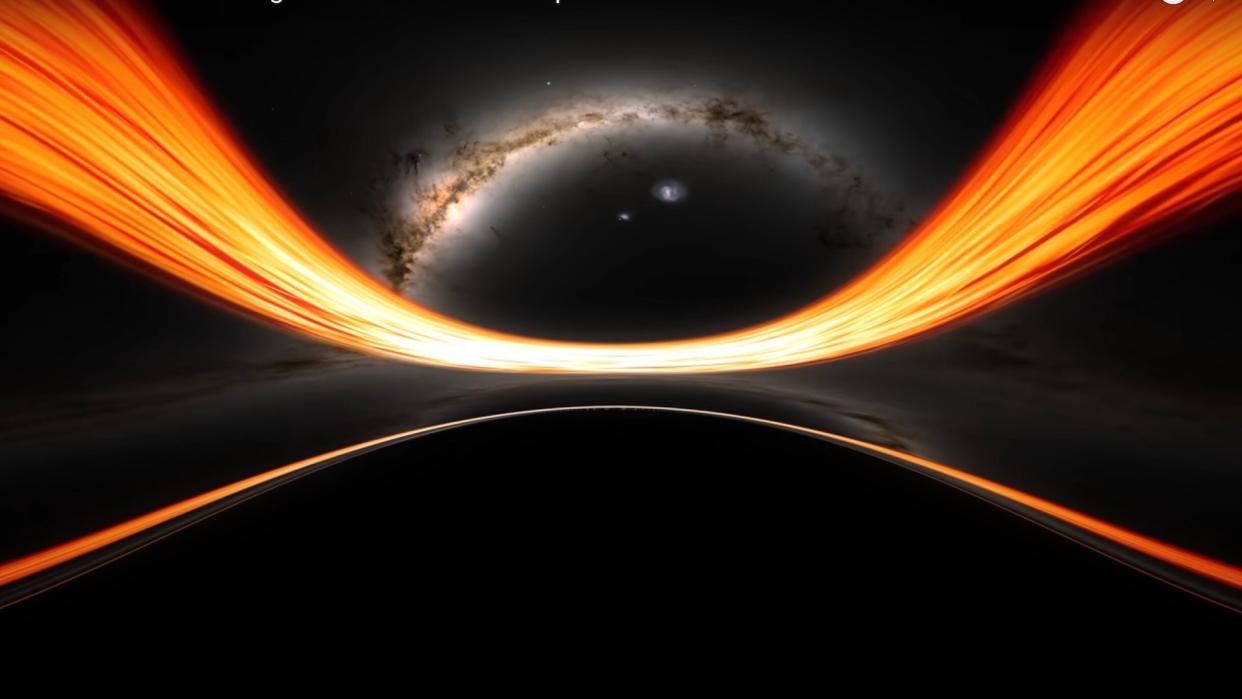Epic NASA video takes you to the heart of a black hole — and destroys you in seconds

Ever wondered what it would be like to fall into a black hole? A new NASA simulation has the answer — including the inevitable, crushing end.
Researchers created the new simulation using the Discover supercomputer at the NASA Center for Climate Simulation. It shows a viewer plunging through the accretion disk of glowing gas around a supermassive black hole like the one at the center of the Milky Way. The viewer cartwheels through the plunge, passing ghostly racetracks of light particles that have orbited the black hole multiple times, finally hitting the point of no return: the event horizon, where nothing, not even light, can escape.
Black holes are the densest objects in the universe. No one knows exactly what matter looks like beyond the event horizon of a black hole, but researchers do know a lot about the physics surrounding these ultra-dense points in space. Around a black hole, gravitational forces are so strong that space-time itself warps. Objects (and space-time itself) approach the speed of light; at these speeds, time seems to slow, such that a person orbiting a black hole for six hours in a spacecraft would age 36 minutes slower than her crewmates on the mothership, according to a NASA statement.
The most common black holes in the universe are star-sized. These stellar-mass black holes have small event horizons, and the extreme gravitational changes over small distances yield violent tidal forces around them. Objects approaching stellar-mass black holes are often torn apart before they even reach the event horizon in a process called spaghettification. Imagine falling feet-first into the black hole: The gravity acting on your feet would be stronger than that acting on your head, causing your body to stretch like a noodle.
Related: 'Twisty' new theory of gravity says information can escape black holes after all
In the new simulation, astrophysicist Jeremy Schnittman of NASA's Goddard Space Flight Center, chose instead to replicate what might happen should someone get too close to a supermassive black hole, like the one at the center of the Milky Way. Thanks to their size, these supermassive black holes are like vast, calm seas in comparison to stellar-mass black holes. You're still going to get spaghettified if you fall into one, but you might make it past the event horizon first.
The black hole at the Milky Way's center has been imaged by the Event Horizon Telescope. In the images, it looks like a doughnut of glowing gas — known as the accretion disk — circling a spot of infinite darkness. It's through this accretion disk that the viewer falls in the new simulation. When they hit the event horizon, the sky narrows and blackness begins to close in; here, light shines in, but can never leave.
RELATED STORIES
–Some stars may be 'infected' with black holes that destroy them from within, new study hints
–Scientists reveal largest map of the universe's active supermassive black holes ever created
–Most massive stellar black hole in the Milky Way discovered 'extremely close' to Earth
The crushing gravitational forces destroy the observer just 12.8 seconds after they pass the event horizon. Microseconds later, whatever is left of their ultra-compressed matter hits the singularity, the center of the black hole. It's a journey of 79,500 miles (128,000 kilometers) from the event horizon to the singularity, but it happens in the blink of an eye.
Schittman also simulated a nonfatal scenario in which an astronaut orbits a black hole a few times and then escapes back to space.
"[S]imulating these difficult-to-imagine processes helps me connect the mathematics of relativity to actual consequences in the real universe," he said in the statement.
